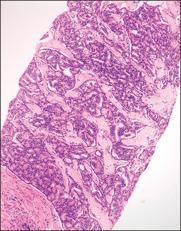当前位置:
X-MOL 学术
›
Lancet Oncol.
›
论文详情
Our official English website, www.x-mol.net, welcomes your feedback! (Note: you will need to create a separate account there.)
Deep-learning approaches for Gleason grading of prostate biopsies.
The Lancet Oncology ( IF 51.1 ) Pub Date : 2020-01-08 , DOI: 10.1016/s1470-2045(19)30793-4 Anant Madabhushi 1 , Michael D Feldman 2 , Patrick Leo 3
The Lancet Oncology ( IF 51.1 ) Pub Date : 2020-01-08 , DOI: 10.1016/s1470-2045(19)30793-4 Anant Madabhushi 1 , Michael D Feldman 2 , Patrick Leo 3
Affiliation

|
Gleason grades are assigned by pathologists based on prostate cancer morphology to describe the loss of tissue structure and order and are strongly correlated with disease aggressiveness and patient outcome. Gleason scoring categorises tumour tissue into patterns from 1 (low risk) to 5 (high risk). Although Gleason grade has long been recognised as being strongly associated with risk of prostate cancer recurrence and metastasis, substantial inter-observer disagreement exists, especially with respect to the intermediate grades. Deep learning, an automated approach using labelled images to train a network with no other assumptions, has proven to be useful in a wide variety of similar areas in digital pathology. Two papers in The Lancet Oncology by Ström and colleagues and Bulten and colleagues use deep learning for detection and Gleason grading of prostate cancer in digital images of biopsies.
中文翻译:

前列腺活检格里森分级的深度学习方法。
病理学家根据前列腺癌的形态划分格里森等级,以描述组织结构和秩序的丧失,并与疾病的侵袭性和患者预后密切相关。格里森评分将肿瘤组织分为从1(低风险)到5(高风险)的模式。尽管长期以来人们一直认为格里森等级与前列腺癌复发和转移的风险密切相关,但观察者之间存在很大分歧,尤其是对于中间等级。深度学习是一种使用标签图像在没有其他假设的情况下训练网络的自动化方法,已被证明在数字病理学的许多类似领域中都是有用的。《柳叶刀肿瘤学》上的两篇论文 Ström和他的同事以及Bulten和他的同事使用深度学习在活检的数字图像中对前列腺癌的检测和格里森分级。
更新日期:2020-01-31
中文翻译:

前列腺活检格里森分级的深度学习方法。
病理学家根据前列腺癌的形态划分格里森等级,以描述组织结构和秩序的丧失,并与疾病的侵袭性和患者预后密切相关。格里森评分将肿瘤组织分为从1(低风险)到5(高风险)的模式。尽管长期以来人们一直认为格里森等级与前列腺癌复发和转移的风险密切相关,但观察者之间存在很大分歧,尤其是对于中间等级。深度学习是一种使用标签图像在没有其他假设的情况下训练网络的自动化方法,已被证明在数字病理学的许多类似领域中都是有用的。《柳叶刀肿瘤学》上的两篇论文 Ström和他的同事以及Bulten和他的同事使用深度学习在活检的数字图像中对前列腺癌的检测和格里森分级。



























 京公网安备 11010802027423号
京公网安备 11010802027423号